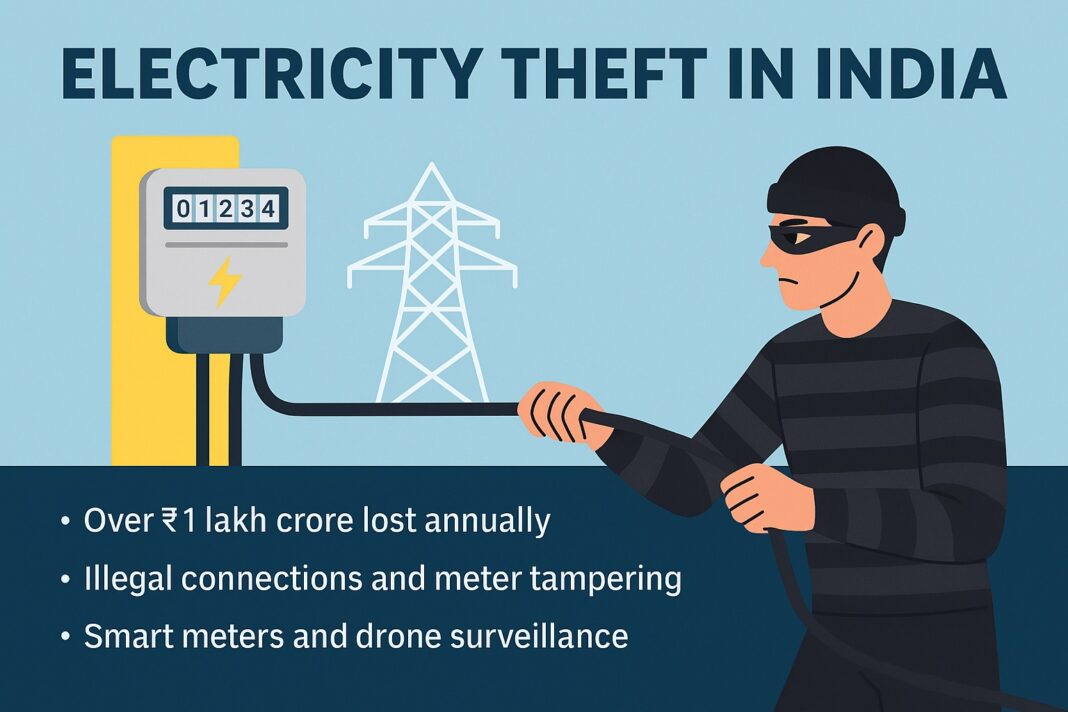Electricity theft remains one of India’s most pressing energy challenges, costing the nation over ₹1 lakh crore annually. From tampered meters to illegal connections, this silent crisis undermines infrastructure, burdens honest consumers, and weakens the financial health of power distribution companies. Despite technological advancements like smart meters and drone surveillance, the problem persists across urban and rural landscapes. This article explores the causes, consequences, and potential solutions to electricity theft in India.
What Is Electricity Theft and Why It Matters
Electricity theft refers to the unauthorized use of electrical power, typically through illegal connections or tampering with meters. In India, this practice is rampant across residential, commercial, and even industrial sectors. It not only causes massive financial losses but also disrupts grid stability and increases tariffs for honest consumers. Power theft is often driven by poverty, lack of awareness, and weak enforcement. The cumulative effect is a weakened energy infrastructure and reduced investment in clean energy. Addressing this issue is essential for ensuring fair access to electricity and building a sustainable energy future.
Annual Financial Losses Due to Power Theft
India loses an estimated ₹1.03 lakh crore annually due to electricity theft. These losses are absorbed by distribution companies (DISCOMs), which then pass the burden onto consumers through higher tariffs. The financial strain also affects the ability of DISCOMs to pay power generators, leading to supply disruptions. In states like Uttar Pradesh, Bihar, and Jharkhand, theft-related losses are particularly high. Without intervention, these losses will continue to grow, undermining national energy goals. Accurate data collection and transparent reporting are key to quantifying and addressing this economic drain.
Common Methods of Electricity Theft in India
Electricity theft in India occurs through various methods: direct hooking from power lines, meter tampering, bypassing meters, and using remote-controlled devices to manipulate readings. In rural areas, hooking is more common, while urban theft often involves sophisticated tampering. Some users even bribe officials to avoid detection. These practices not only endanger lives but also overload the grid, causing frequent outages. Understanding these methods is crucial for designing effective countermeasures, including tamper-proof meters and real-time monitoring systems.
Impact on Consumers and the Power Sector
Electricity theft affects everyone. Honest consumers face inflated bills due to cross-subsidization, while DISCOMs struggle with cash flow and infrastructure upgrades. Frequent outages and voltage fluctuations are common in theft-prone areas. The sector’s credibility suffers, discouraging private investment and innovation. Moreover, theft undermines government schemes like Saubhagya and UDAY, which aim to improve electrification and financial health of DISCOMs. Tackling theft is not just a technical issue-it’s a matter of fairness and trust in public utilities.
Role of Technology in Preventing Electricity Theft
Technological interventions like smart meters, drone surveillance, and AI-based monitoring are transforming theft detection. Smart meters provide real-time usage data and alert authorities to anomalies. Drones help inspect remote areas without physical risk. AI algorithms can flag suspicious consumption patterns. Initiatives like “Operation Teetariya” in Uttar Pradesh have shown promising results. However, technology alone isn’t enough-it must be backed by legal enforcement and public cooperation. Investing in tech-driven solutions is vital for a theft-free power ecosystem.
Legal Framework and Penalties for Power Theft
India’s Electricity Act, 2003, outlines strict penalties for electricity theft, including fines and imprisonment. Yet enforcement remains inconsistent. Many cases go unreported or unresolved due to corruption and lack of awareness. Strengthening legal mechanisms, fast-tracking cases, and ensuring accountability are essential. Public awareness campaigns can also deter theft by highlighting consequences. A robust legal framework, combined with community vigilance, can significantly reduce theft and restore trust in the system.
State-Wise Analysis of Electricity Theft
States like Uttar Pradesh, Bihar, West Bengal, and Rajasthan report the highest levels of electricity theft. In contrast, states with better infrastructure and governance-like Gujarat and Maharashtra-have lower theft rates. This disparity highlights the role of local administration, public awareness, and investment in technology. State-wise audits and benchmarking can help identify best practices and areas needing intervention. Tailored strategies for each state are more effective than one-size-fits-all policies.
Future Roadmap: Building a Theft-Free Power System
India’s roadmap to eliminate electricity theft must include a multi-pronged approach: technological upgrades, legal reforms, public education, and administrative accountability. DISCOMs should invest in smart infrastructure and data analytics. Governments must enforce laws strictly and incentivize honest usage. Schools and media can play a role in shaping public attitudes. A theft-free power system is not just a dream-it’s a necessity for India’s energy security, economic growth, and climate goals.
Disclaimer: The articles, videos, and news published and shared on Theconnect24.com covering topics such as religion, astrology, health, yoga, history, mythology, and others are intended solely for general informational purposes. These materials are sourced from various references, and Theconnect24.com does not guarantee or verify their accuracy, completeness, or authenticity. Viewers are strongly advised to seek guidance from qualified experts or specialists before practicing, following, or experimenting with any information related to astrology, health, or similar subjects. This content is presented purely for the interest of viewers and does not carry any scientific validation or evidence.



